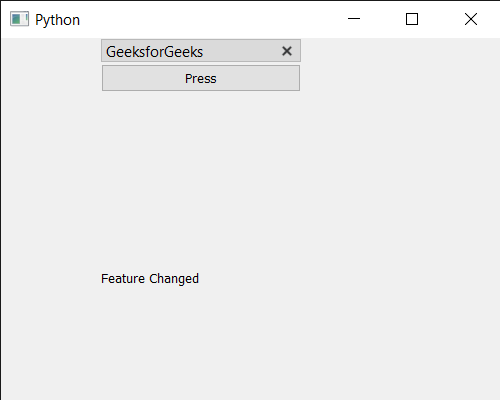En este artículo veremos cómo podemos obtener la señal de cambio de función del QDockWidget. QDockWidget proporciona el concepto de widgets de base, también conocidos como paletas de herramientas o ventanas de utilidades. Las ventanas del muelle son ventanas secundarias ubicadas en el área del widget del muelle alrededor del widget central en una QMainWindow (ventana original).
Hay muchas funciones ya habilitadas para el muelle, también hay funciones como barra de título móvil, cerrable, flotante, horizontal o hay una opción de configurar todas las funciones o configurar ninguna función, estas se pueden configurar con la ayuda del setFeaturesmétodo. La señal de cambio de función se emite cuando se cambia la función de la base.
Para hacer esto, usaremos
featuresChangedel método con el objeto del widget del muelle.Sintaxis: dock.featuresChanged.connect(método)
Argumento: toma el método como argumento
Retorno : Devuelve Ninguno
A continuación se muestra la implementación.
# importing libraries
from PyQt5.QtWidgets import *
from PyQt5 import QtCore, QtGui
from PyQt5.QtGui import *
from PyQt5.QtCore import *
import sys
class Window(QMainWindow):
def __init__(self):
super().__init__()
# setting title
self.setWindowTitle("Python ")
# setting geometry
self.setGeometry(100, 100, 500, 400)
# calling method
self.UiComponents()
# showing all the widgets
self.show()
# method for components
def UiComponents(self):
# creating dock widget
dock = QDockWidget("GeeksforGeeks", self)
# push button
push = QPushButton("Press", self)
# setting widget to the dock
dock.setWidget(push)
# creating a label
label = QLabel("GeeksforGeeks", self)
# setting geometry to the label
label.setGeometry(100, 200, 300, 80)
# making label multi line
label.setWordWrap(True)
# getting feature changed signal
# setting text to the label when feature is changed
dock.featuresChanged.connect(lambda: label.setText("Feature Changed"))
# setting feature to the dock
dock.setFeatures(QDockWidget.DockWidgetClosable)
# setting geometry tot he dock widget
dock.setGeometry(100, 0, 200, 30)
# create pyqt5 app
App = QApplication(sys.argv)
# create the instance of our Window
window = Window()
# start the app
sys.exit(App.exec())
Producción :
Publicación traducida automáticamente
Artículo escrito por rakshitarora y traducido por Barcelona Geeks. The original can be accessed here. Licence: CCBY-SA